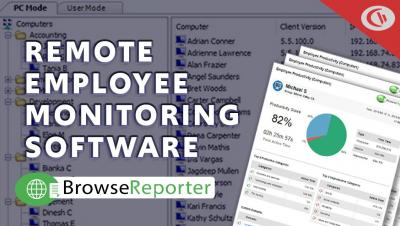Security | Threat Detection | Cyberattacks | DevSecOps | Compliance
Insider Threats
The latest News and Information on Insider Threats including employee monitoring and data privacy.
Employee Internet Monitoring - Web Usage Activity Alerts | BrowseReporter
Securing your businesses beyond the office perimeter
For most businesses, the corporate boundaries have expanded over time. The traditional office has now morphed into a hub-and-spoke model with an increasing number of employees working remotely. This shift to remote work isn't new. Between 2005 and 2018, there was a 173% rise in the US remote workforce. The trend spiked in 2020 when 88% of organizations worldwide encouraged remote work to flatten the pandemic's spread.
Remote Employee Monitoring Software - How To Audit Employee Computer Activity | CurrentWare
How Software Can Help With A Digital Workforce Transformation
A growing number of businesses are allowing their employees to work remotely for at least part of their work week. Right now, it’s estimated that 42% of workers in the U.S. are working from home. Even though working from home is becoming more common, many companies have still not taken the necessary steps to complete their digital workforce transformation. The key to successfully shifting to remote work is keeping tabs on your team with the help of employee monitoring software.
Insider Threats: Risk Assessment Considerations for Remote Work
The outbreak of COVID-19 has led many businesses to transition a large number of employees to remote work. The shift could end up becoming a long-term trend; it’s expected to continue after the pandemic ends. Therefore, it is more important than ever to develop strategies for managing and responding to risks within your organization. Internal risk management procedures will need to adapt to the issue of insider threats, a challenge which is compounded by remote work.
The Future of Ransomware: Preparing for the Next Generation of Ransomware Attacks
Ransomware has been the scourge of cybersecurity and may have led to a recent death. Now it soon may get way more dangerous The threats to cybersecurity are constantly evolving. As security teams develop solutions to the threats, malicious actors change their tactics to keep chasing their ill gotten gains. After all, the Game is the Game. And the game keeps changing. In recent years, ransomware has been the weapon of choice for hackers looking for a payday.
Grow your Small Business with Workforce Intelligence
Did you know that collecting data regarding employee behaviors and patterns can help business owners create accurate, efficient business plans? Companies are using workforce intelligence to accurately and objectively build stronger internal organizations using big data. Workforce intelligence uses a combination of artificial intelligence, SaaS tools, analytics, and visual reporting to help employers oversee and manage employees more effectively.
Going Beyond Insider Threats: How to Balance Post-COVID Cybersecurity with Productivity Data for Remote Employees
For many organizations, the past several years have been defined by an unending pursuit of data privacy and cybersecurity. Prompted by a daunting threat landscape, new regulatory standards and increasingly onerous consequences, companies invested millions in securing their digital infrastructure as an all-in attempt to meet the moment.
Employee Monitoring For the Remote Workforce
Remote work has become increasingly popular over the last several years. But in 2020, the number of remote workers grew exponentially as a result of the coronavirus pandemic. Even though the lockdowns have ended, many companies have allowed their employees to continue working remotely. According to Gallup, 33% of workers in the U.S. are working remotely all the time and 25% of workers are working remotely at least some of the time.







